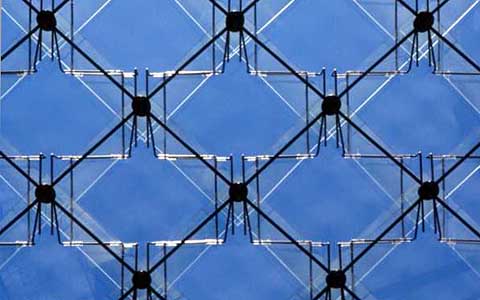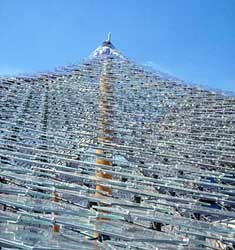|
|
|
Three aesthetics with an innovative impact on the structural applications of glass
Curved surface aesthetics
Curved surface aesthetics
/ Rhön Clinic, Bad Neustadt
|
 Rhön Clinic glass roof detail
| ||
|
Curved surface aesthetics
A structure exists to create a space that fulfills its required functions and expressions. The structure should aspire to embody the following ideals: to ultimately further refine the image of the space, to be beautiful as a structure in its own right, to be fully adaptable and to be free and unrestricted in its creation. These are some examples of this sort of architecture.
 Rhön Clinic
|
Rhön Clinic, Bad Neustadt���
The glazed steel cable net covering the space between the buildings of the Rhön Clinic in Bad Neustadt is the first steel cable net in the world to be glazed with silicate glass. This is the first successful design to combine the two extremely efficient methods of glazing and steel cable net construction.
The basis for the feasibility of this design is a patented method developed by Werner Sobek and his staff, of fixing overlapped or "shingled" glass panels of uniform size to a steel cable net of varying mesh geometry using standardized stainless steel clips. The net consists of galvanized high-tensile steel cable. Its curved shape was defined using CAD-based form-finding methods. The nodal points of the net serve as mounting points for the clips which secure the glass "shingled" The cable net is edged with steel cables which transfer the forces to wooden compression struts or guy cables. The timber compression struts are of laminated construction and have been milled to the required shape; they are up to 12m long. The glass shingles are made from laminated safety glass. During assembly, the steel clips are clipped to each shingle on the ground. Subsequently, each glazing unit is clipped to its respective node in the cable net. Ridge cappings and edge guttering are made of poly-carbonate. Architect:Lamm, Weber & Donath, Stuttgart | |
|
LINKS In English
| ||
 |
|||||